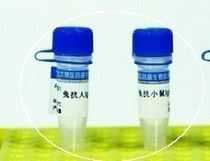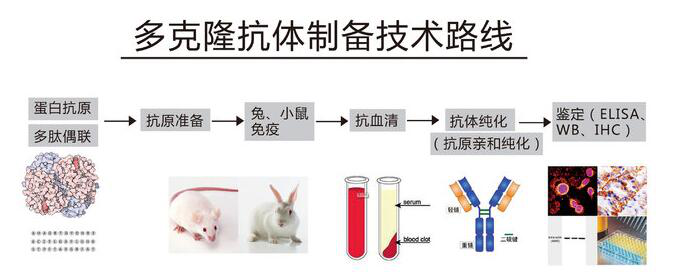
|

| 产地 | 进口、国产 |
| 品牌 | 上海莼试 |
| 保存条件 | Store at -20 °C |
| 货号 | CS10161 |
| 应用范围 | WB=1:100-500 ELISA=1:500-1000 IP=1:20-100 IHC-P=1:100-500 IHC-F=1:100-500 IF=1:100-500 |
| CAS编号 | |
| 抗体名 | Anti-Peptide YY/PYY |
| 克隆性 | |
| 靶点 | 详见说明书 |
| 适应物种 | 详见说明书 |
| 形态 | 详见说明书 |
| 宿主 | 详见说明书 |
| 亚型 | IgG |
| 标识物 | 详见说明书 |
| 浓度 | 1mg/1ml% |
| 免疫原 | KLH conjugated synthetic peptide human Peptide YY/PYY |
全、新、优、品、好四大特点:
酪酪肽抗体费用 全:公司提供上万种产品,涵盖了生物试剂,elisa试剂盒,标准品,培养基,原装耗材,抗体、培养基、ATCC细胞等,基本上各种科研所需产品在我司都能找到。
新:产品更新速度较快,基本上每周都有新产品出现。
优:产品质量好,投诉比较少。
好:我公司具有优质的技术团队,产品一旦售出,实验过程中遇到困难可提供在线技术咨询。使您使用产品时没有任何的后顾之忧。
酪酪肽抗体费用 英文名称 Anti-Peptide YY/PYY
中文名称 酪酪肽抗体费用
别 名 RATGHYY; GHYY; MGC19143; Peptide tyrosine tyrosine; peptide YY; Peptide YY like; Peptide YY precursor; PYY 1; PYY; PYY II; PYY1; PYYI; Yy; PYY_HUMAN.
产品属性:
浓 度 1mg/1ml
规 格 0.2ml/200μg
抗体来源 Rabbit
克隆类型 polyclonal
交叉反应 Human
产品类型 一抗
研究领域 心 免疫学 神经生物学 生长因子和激素 病
蛋白分子量 predicted molecular weight: 4.4kDa
性 状 Lyophilized or Liquid
免 疫 原 KLH conjugated synthetic peptide human Peptide YY/PYY
亚 型 IgG
纯化方法 affinity purified by Protein A
储 存 液 0.01M PBS, pH 7.4 with 10 mg/ml BSA and 0.1% Sodium azide
酪酪肽抗体费用 产品应用 WB=1:100-500 ELISA=1:500-1000 IP=1:20-100 IHC-P=1:100-500 IHC-F=1:100-500 IF=1:100-500
(石蜡切片需做抗原修复)
not yet tested in other applications.
optimal dilutions/concentrations should be determined by the end user.
保存条件 Store at -20 °C for one year. Avoid repeated freeze/thaw cycles. The lyophilized antibody is stable at room temperature for at least one month and for greater than a year when kept at -20°C. When reconstituted in sterile pH 7.4 0.01M PBS or diluent of antibody the antibody is stable for at least two weeks at 2-4 °C.
Important Note This product as supplied is intended for research use only, not for use in human, therapeutic or diagnostic applications.
产品介绍 Peptide tyrosine tyrosine (PYY) was originally isolated from porcine gut, which exhibits striking sequence homology with members of the pancreatic polypeptide family, including neuropeptide tyrosine (NPY). The peptide is localized to enteroglucagon containing (L/EG) and pancreatic (A) cells in many mammalian and non-mammalian species. PYY gene expression is upregulated by various growth factors, including growth hormone and insulin-like growth factor and the physiological effects of PYY are mediated by G-protein (G alpha i2) coupled Y-type receptors (‘Y2 receptors of a PYY preferring subtype’). Various actions have been reported for PYY, including the inhibition of upper intestinal and exocrine pancreatic secretion, small intestinal water flux and as the mediator for the fat-induced ileal brake. Recently, the infusion of normal postprandial concentrations of PYY[3-36] into human volunteers has been shown to significantly decrease appetite and reduce food intake, possibly via Y2R in the arcuate nucleus. Immunohistochemical studies on mice have shown that PYY is the earliest detectable peptide in both pancreatic islets and colonic endocrine cells which suggest that PYY may be a useful marker for endocrine progenitor cells.
PYY1-36(human):
Tyr-Pro-Ile-Lys-Pro-Glu-Ala-Pro-Gly-Glu-Asp-Ala-Ser-Pro-Glu-Glu-Leu-Asn-Arg-Tyr-Tyr-Ala-Ser-Leu-Arg-His-Tyr-Leu-Asn-Leu-Val-Thr-Arg-Gln-Arg-Tyr-NH2
CAS Number: 118997-30-1; Empirical Formula (Hill Notation): C194H295N55O57; Molecular Weight: 4309.75
Subcellular Location : Secreted.
Similarity : Belongs to the NPY family.
Database links : UniProtKB/Swiss-Prot: P10082.3
酪酪肽简介
酪酪肽PYY又称肠道衍生激素酪酪肽,属胰多肽家族成员,因它可使机体产生饱感、减少摄食和体重而为人们所知。随着进一步的深入研究,又发现其具有多种生物功能。
1、 PYY的蛋白结构:PYY与胰多肽(PP)和神经肽Y(NPY)具有较高的序列同源性,故认为属胰多肽家族 。PYY是一种具有酰胺化羧基末端的肽类物质,为直链多肽,其分子结构为36个氨基酸缩合而成该肽的氨基和羧基末端的氨基酸残基均为酪氨酸(Tyrosine,Tyr)。在循环系统中,PYY以PYY1-36 和PYY3-36两种形式存在 。
2、 PYY的分泌及影响因素: PYY主要由和直肠的L细胞以和旁分泌两种方式分泌;
a.初期PYY是由的细胞所产生,该激素与胃肠道的形成和发育过程具有一定的关系。
b.PYY也可以由胃和*的细胞所分泌,同时在中枢(下丘脑、脑干、髓质、脑桥和脊髓)和末梢的神经元中存在。
c.在*内,PYY主要和胰素在胰岛的α细胞内共同表达。PYY在初期胰岛细胞前体中的表达,说明它在*的分化增殖和发育过程中起了重要的作用,从两栖类动物的皮肤中也分离出一种PYY,称为S-PYY。
3、PYY的作用:
a.:在体内和体外实验中PYY可以。PYY是间接通过减少胰素的作用来影响的分泌。由于和PYY都是由胰岛的β细胞分泌,因此,PYY可能是经过旁分泌方式来调节的分泌,但胰素和PYY是否一起被分泌还需要进一步的研究。
b.PYY还可以通过作用于中枢来。PYY可能与脑干内的Y1和Y2受体结合来调节迷走神经和影响摄食功能,这其中就包括调节的分泌。
c.:PYY 可以以及减少胃蛋白酶的含量,同时还可以增加血液中PYY的浓度。
d.PYY对摄食行为的调节: PYY的浓度在摄食前下降和摄食后增加,表明PYY是一个调节摄食的饱感信号。
实验流程:

正在热销的相关产品:
ORX-A(orexin-A) 增食欲素-A/欲激素A抗原Multi-class antibodies规格: 0.5mg
Anti-Phospho-beta-Arrestin 1(Ser412) 磷酸化β抑制蛋白1抗体Multi-class antibodies规格: 0.1ml
Rhesus antibody Rh phospho-ASK1(Ser1033) 磷酸化细胞凋亡信号调节激酶1抗体 规格 0.1ml
Tubulin-alpha 浓缩液 0.1ml 进口分装
UGP2 英文名称: 尿苷酰二磷酸葡萄糖焦磷化酶2抗体 0.2ml
DNAJC7 英文名称: DNAJC7蛋白抗体 0.2ml
Anti-Phospho-beta-Arrestin 1(Ser412) 磷酸化β抑制蛋白1抗体Multi-class antibodies规格: 0.1ml
ILK-1(Human) 人整合素连接激酶1Multi-class antibodies规格: 48T
Anti-CRF/CRH 促肾上腺皮质激素释放因子抗体Multi-class antibodies规格: 0.1ml
Rhesus antibody Rh NKG2D/CD314/KLRK1 NK细胞受体2D抗体 规格 0.1ml
Human tenascin-R,TN-R ELISA Kit 人肌腱蛋白R 96T
TrkA 英文名称: 酪酸激酶受体A抗体 0.1ml
Centrin 2 英文名称: 中心体蛋白2抗体 0.1ml
Anti-CRF/CRH 促肾上腺皮质激素释放因子抗体Multi-class antibodies规格: 0.1ml
PROG ELISA kit 大鼠孕激素/孕酮Multi-class antibodies规格: 48T
Anti-ARHI/FITC 荧光素标记ARHI蛋白抗体IgGMulti-class antibodies规格: 0.2ml
Rhesus antibody Rh FAM13B1 FAM13B1蛋白抗体 规格 0.2ml
CaN ELISA Kit 大鼠钙调磷酸酶 96T
5 MethylCytosine 英文名称: 5甲基胞嘧啶抗体 0.1ml
phospho-Androgen Receptor (Ser791) 英文名称: 磷酸化雄激素受体抗体 0.1ml
Anti-ARHI/FITC 荧光素标记ARHI蛋白抗体IgGMulti-class antibodies规格: 0.2ml
rEPC,大鼠内皮祖细胞-骨髓
KYSE450 人细胞
ITGA8 & ITGB1 Others Human 人 ITGA8 & ITGB1 Heterodimer 人细胞裂解液 (阳性对照)
CL-0328CEM/C1(人急性淋巴细胞细胞)5×106cells/瓶×2
人毛细胞总RNAHHDPC NA
人皮肤成纤维样细胞;HSF2 人细胞完全培养基 100mL
CL-0164NAMALWA(人Butt's细胞)5×106cells/瓶×2
CD84 Others Cynomolgus 食蟹猴 CD84 人细胞裂解液 (阳性对照)
人成纤维细胞-心室裂解物HCF-av L
CCD-1095Sk细胞,人浸润性导管癌旁皮肤细胞 鼠细胞,H22-H8D8细胞 脑成纤维细胞Many types of cells包装:5 × 105次方(1ml)
BC3H1(小鼠细胞) 5×106cells/瓶×2
HUASMC Pellet 人脐动脉平滑肌细胞团块 > 1 mio.cells 人上皮细胞裂解物HPEpiCL
酪酪肽抗体费用 rEPC,大鼠内皮祖细胞-骨髓
KYSE450 人细胞
ITGA8 & ITGB1 Others Human 人 ITGA8 & ITGB1 Heterodimer 人细胞裂解液 (阳性对照)
CL-0328CEM/C1(人急性淋巴细胞细胞)5×106cells/瓶×2
人毛细胞总RNAHHDPC NA
人皮肤成纤维样细胞;HSF2 人细胞完全培养基 100mL
技术外包服务:
★酪酪肽抗体费用 分子生物学:质粒抽提、PCR、Q-PCR、RT-PCR、分子生物学:基因合成、引物合成、基因测序、载体构建等
★蛋白工程:原核、哺乳动物蛋白表达系统等
★病毒包装:腺病毒、慢病毒等
★抗体工程:磁珠分选、病理染色、WB、ELISA、IP、IF、IHC、FACS、Confocal等等
★细胞工程:细胞表型分析(凋亡、增殖、周期、迁移、侵袭、修复、克隆形成)、细胞培养、细胞膜制备、稳定细胞株构建、细胞RNAi技术等等。